Financial Stability Review – October 2017 3. The Australian Financial System
The Australian financial system remains resilient and its ability to withstand adverse shocks continues to be strengthened. Banks' capital levels are well above current regulatory minimums and, for the major banks, are around the top quartile of international peers on a comparable basis. Banks' capital has been boosted by high profit levels over recent years. While net interest margins have trended lower they are now widening as funding conditions improve and the effects of recent loan repricing are realised. Bad and doubtful debts remain around historical lows, despite rising mortgage loan arrears in mining-related regions.
In July, the Australian Prudential Regulation Authority (APRA) announced the additional capital required for Australian authorised deposit-taking institutions (ADIs) to be considered ‘unquestionably strong’. The major banks will need to target a Common Equity Tier 1 (CET1) capital ratio of around 10.5 per cent by January 2020 (based on the current capital framework), while the effective increase in capital requirements for smaller ADIs will be around 50 basis points. APRA also announced that it intends to set new capital standards, expected to become effective from 2021, that will include minimum requirements consistent with these benchmarks. Banks are well placed to meet these higher requirements through retained earnings and dividend reinvestment plans, having already increased their capital in anticipation of these changes. After reaching these new benchmarks, banks will have completed a substantial increase in their capital ratios since the onset of the financial crisis. APRA plans to release a discussion paper later this year setting out modifications to the underlying capital framework, including changes to address banks' high concentration of residential mortgages. APRA's intention is that any changes to this framework will not result in further increases to aggregate capital requirements.
The increase in banks' capital over recent years has made them more resilient and lowered their return on equity (ROE). Despite this, investors appear to still be expecting similar returns to those sought a decade ago. This tension could motivate banks to seek higher returns by taking on additional risks. Regulators have increased their focus on the risk culture of banks and the industry is taking steps to strengthen their approach to certain risks.
Tighter standards for banks' lending to the property market over recent years have created an opportunity for shadow banks to expand. Yet available evidence indicates that shadow banks' share of residential mortgage lending has increased only slightly, and from a low level. There are several constraints to such lending growing rapidly. Shadow banks' lending for property development has increased more strongly, but it has not been enough to fully replace the pullback by banks.
Non-bank financial institutions are also in good condition, though they face some challenges. General insurers are addressing historically low profitability by reversing earlier declines in some commercial premiums. Life insurers are responding to ongoing structural issues by reducing risk through greater use of reinsurance and raising capital ratios. Risks from the superannuation sector remain limited due to its modest use of leverage, even in self-managed superannuation funds. Financial market infrastructures have also continued to function effectively and are working to reduce possible vulnerabilities.
Banks' Domestic Asset Performance
The performance of Australian banks' domestic assets was little changed overall in the first half of 2017, although this masks some variation by asset type (Graph 3.1). The share of non-performing housing loans increased a little. However, banks' non-performing housing loans are mostly well secured, with the impaired share very low (Graph 3.2).[1] By state, delinquencies are highest in Western Australia, Queensland and South Australia. In liaison with the Reserve Bank, some banks continued to report that they do not expect loan performance to deteriorate much further in Western Australia. Banks also reported some worsening in the performance of personal loans. Weaker economic conditions in Western Australia and Queensland have contributed to higher arrears on personal loans. Changes in banks' reporting of loans granted hardship concessions also pushed up the share of non-performing personal loans. This has little impact on banks' overall loan performance as personal lending remains a very small share of banks' total lending. In contrast to household loans, aggregate business loan performance has improved further, supported by low interest rates. Impairments on commercial property exposures remain low.
Future asset performance will continue to be influenced by developments in property markets and the resources sector, as well as macroeconomic conditions more generally.
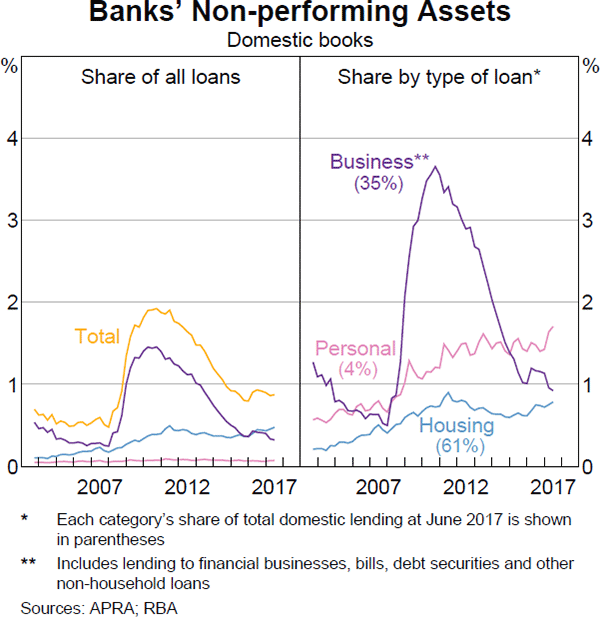

The strengthening in housing lending standards over recent years should support future loan performance.
Credit Conditions
Total credit growth was little changed over the past six months and is still slightly faster than nominal income growth (Graph 3.3). Housing credit growth was stable in aggregate, with some slowing in the growth of investor credit being offset by faster growth in owner-occupier credit. The moderation in investor credit follows the increases in investor and interest-only interest rates and is broadly akin to the slowing observed after APRA announced limits on investor housing credit growth in late 2014.
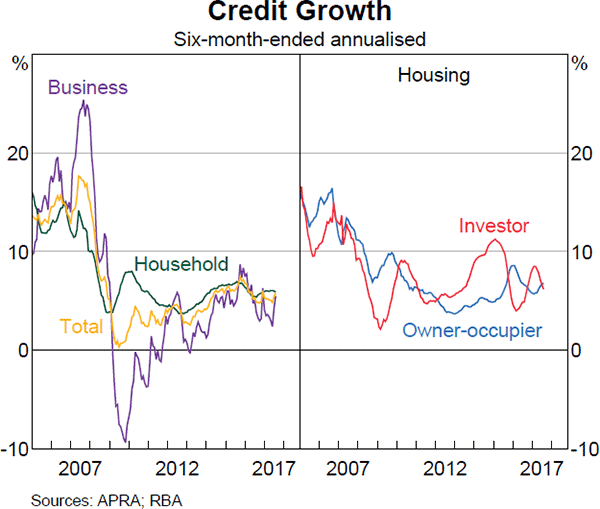
Business credit growth has picked up in recent months following a slowing earlier in the year, although it remains modest relative to history. The major banks have reduced their commercial property exposures and reported a further tightening in standards for residential development lending. However, lending by foreign-owned banks operating in Australia has continued to increase, driven primarily by banks headquartered in Asia (Graph 3.4). Asian banks now supply 12 per cent of total business credit in Australia, compared with 6 per cent in 2012, with this growth driven particularly by infrastructure and commercial property lending. Some Asian banks have concentrated exposures to particular companies or sectors. Rapid expansion by foreign banks has in the past exacerbated asset price and economic cycles by amplifying the credit supply cycle and could lead domestic banks to loosen lending criteria to remain competitive. To date, these risks to lending standards appear to have been contained, and indeed standards have been tightened in response to APRA's onsite reviews of commercial property lending. It will be important to remain vigilant about risks that can be precipitated by foreign bank lending.
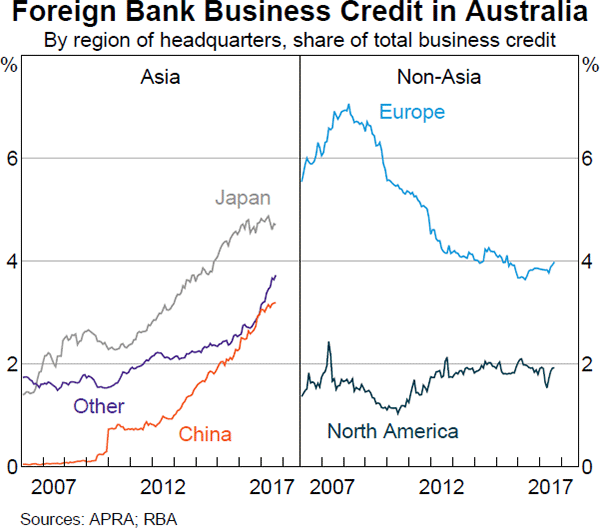
International Exposures
Australian-owned banks have continued to reduce their international lending exposures over the past year, other than in New Zealand (Graph 3.5). The decline has been spread across a range of countries and is consistent with the desire of several banks to scale back from lower return businesses, particularly lending to institutional customers. Exposures to Asia are expected to fall further as ANZ completes the sale of some retail banking and wealth management businesses over coming months.
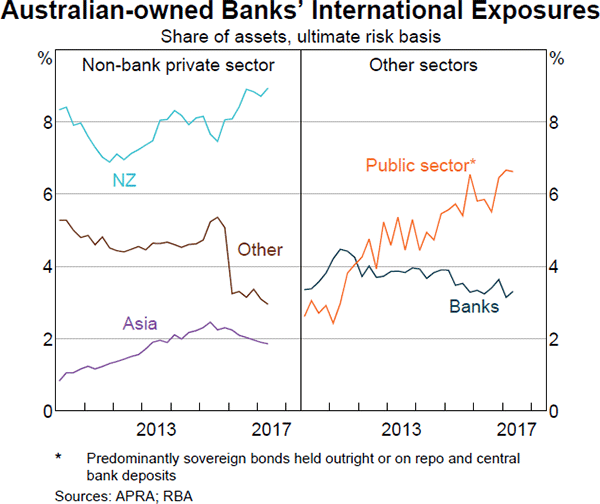
In contrast, Australian-owned banks' lending exposures in New Zealand and their international sovereign exposures (which mainly comprise government bonds and central bank deposits) have grown a little faster. The increase in lending to New Zealand has been mainly for housing, where risks are elevated, as discussed in ‘The Global Financial Environment’ chapter. While arrears for New Zealand housing are currently at their lowest level in at least a decade, the rising share of banks' exposures to New Zealand and Australian housing markets has reduced their diversification given the correlation of these housing markets over an extended period. However, this shift towards housing lending, which historically generates higher return on equity, has also supported their profits.
Liquidity and Funding
Australian banks have maintained resilience to potential liquidity and funding shocks. Banks' Liquidity Coverage Ratios, which measure their buffers of liquid assets against short periods of liquidity stress, are reasonably above the 100 per cent minimum requirement. Banks' Net Stable Funding Ratios, which measure the extent more stable liabilities are used to fund less liquid assets and which will become binding from next year, have mostly risen close to banks' target levels.
Australian banks have ample access to a range of funding sources at a lower cost than one year ago. Deposits inflow has been strong, such that despite reducing the interest rates paid on deposits, they have grown more quickly than assets over the past year (Graph 3.6). Spreads on banks' short-term and long-term wholesale funding have also narrowed considerably, with long-term spreads around their lowest level since the financial crisis (Graph 3.7). The strong growth in deposit funding has meant banks have only slightly increased their funding from wholesale markets in absolute terms, and reduced it as a share of total liabilities. Conditions in residential mortgage-backed securities (RMBS) markets have also improved: spreads have declined a little but remain well above pre-crisis levels. RMBS issuance by smaller Australian banks has picked up, but is also well below pre-crisis levels.
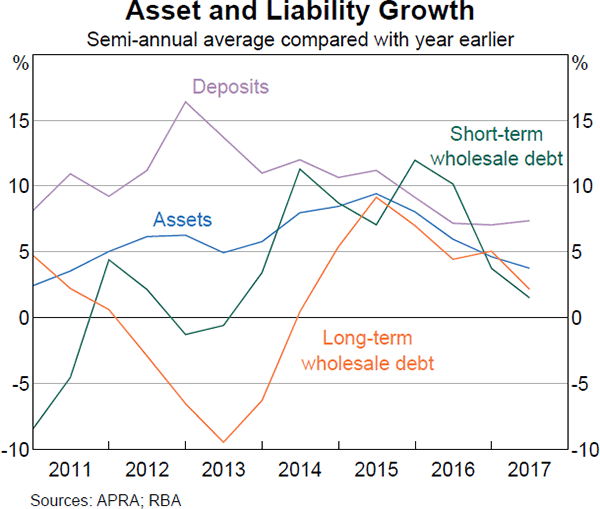
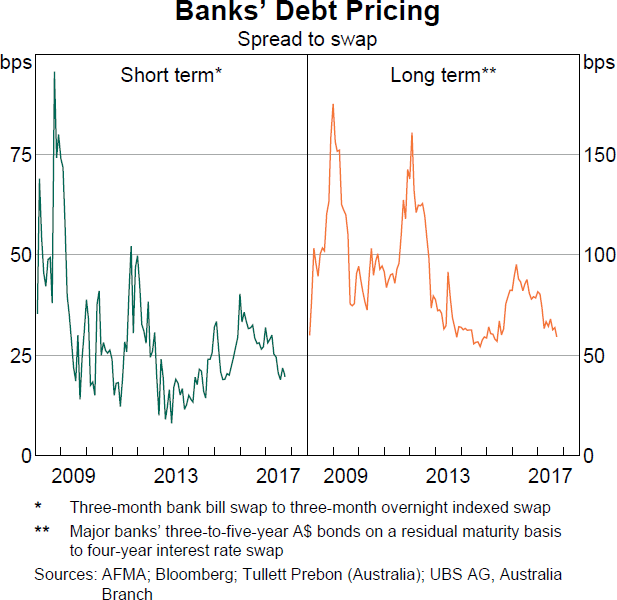
The ratings of many Australian financial institutions were downgraded by credit rating agencies in recent months, largely due to concerns about high and rising household debt. Standard & Poor's downgraded 23 institutions, but affirmed the ratings of the major banks (because of an unchanged assumption of sovereign support) and Macquarie Bank. Moody's downgraded 12 institutions, bringing its ratings for the major banks into line with other major ratings agencies at AA–. These ratings actions led to some deposit outflows for some non-major banks, but the impact was small and temporary because of the strong growth in deposit markets.
Capital and Profits
Australian banks' resilience to adverse shocks is underpinned by their capital positions, which are above current minimum requirements. Each of the major banks' CET1 capital ratios are well above the current 8 per cent threshold, and around the top quartile of large international banks when measured on a comparable basis (Graph 3.8). Capital ratios at most other ADIs are higher still. The leverage ratios of the major banks – the ratio of Tier 1 capital relative to total non-risk-adjusted exposures – are also around the top end of the 3–5 per cent range that was expressed as ‘appropriate’ for a minimum requirement in the 2014 Financial System Inquiry (FSI). However, the major banks' leverage ratios have typically been around or a bit below the median of international banks because of Australian banks' greater exposure to residential mortgages, which have historically experienced fewer losses and so have lower risk weights.
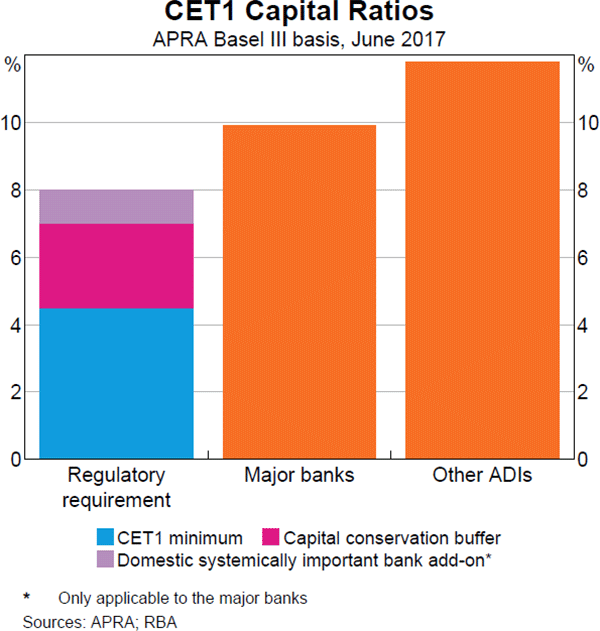
APRA released an information paper in July that set out the additional capital required for Australian ADIs to be considered ‘unquestionably strong’.[2] This fulfilled one of the main recommendations from the FSI. APRA's expectation is that all ADIs meet the new capital benchmarks by 2020.
- The major banks will need to target a CET1 capital ratio of around 10.5 per cent (based on the current capital framework). This corresponds to a CET1 capital ratio of more than 15 per cent on an internationally comparable basis, and should put the major banks' CET1 ratios comfortably within the top quartile of large international banks.
- For smaller ADIs using the standardised approach to credit risk, the effective increase in CET1 capital requirements will be around 0.5 percentage points.
APRA plans to release a discussion paper later this year with proposed revisions to the capital framework that are expected to be implemented from 2021. In this, APRA intends to outline how it will implement changes to the international Basel III capital framework if it is finalised by then. It intends to also address the Australian banking system's high concentration of residential mortgages. In particular, APRA has indicated that it will seek to target higher-risk lending, building on the revised Basel III framework that will likely modify risk weights for higher loan-to-valuation (LVR) loans and identify separate risk weights for investor lending. APRA expects that any changes to the capital framework will not necessitate further increases to banks' aggregate capital.[3]
Banks are well positioned to meet the ‘unquestionably strong’ capital targets, having increased capital markedly over recent years in anticipation of higher regulatory requirements (Graph 3.9). APRA estimates that the major banks should be able to generate the additional required capital from retained earnings, without significant changes to asset growth or dividend policies, or the need for equity raisings. Many smaller ADIs already hold enough capital to meet the effective increase in requirements.
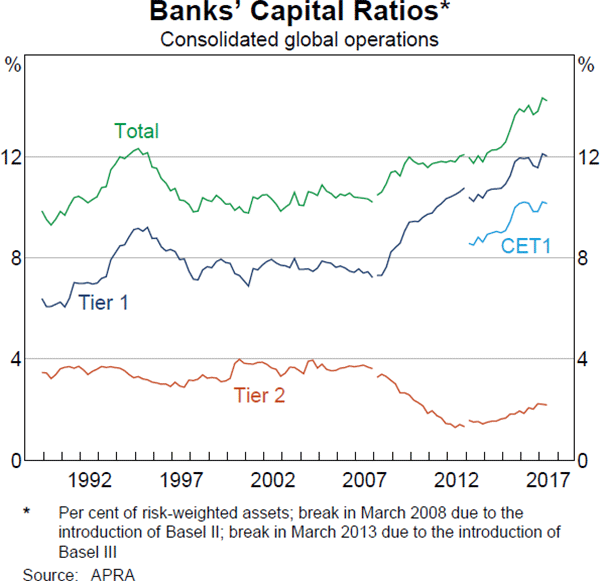
Reaching a CET1 capital ratio of 10.5 per cent will complete a substantial strengthening of the major banks' capital position over recent years. Their CET1 capital ratio will be around 2½ percentage points higher than when the FSI's proposal was released in late 2014 (including the effect of higher residential mortgage risk weights applied from mid 2016) and their Tier 1 capital ratio will be around 6 percentage points higher than before the financial crisis. APRA has also estimated that the major banks' leverage ratio could increase to around 6 per cent following the substantial strengthening in capital, somewhat higher than the current international median.
A sizeable portion of banks' capital accumulation in recent years has come from retained profits or reinvested dividends flowing from their high profits. Profits remained high in the latest period, but there has been very little growth since 2014, both in headline and underlying terms (Graph 3.10). One reason for the lack of profit growth is that banks have divested wealth management and life insurance operations; another is that their net interest margins have compressed, partly reflecting increased holdings of low-yielding, high-quality liquid assets. In addition, while charges for bad and doubtful debts remain around historically low levels, they are no longer falling and so are not adding to profits as they did prior to 2014. (Profits are an important contributor to banks' resilience during stress, as highlighted in ‘Box D: Stress Testing at the Reserve Bank’.)
Analysts expect profits to increase over the coming year. Recent loan repricing and reduced funding costs are expected to drive some increase in the net interest margin, leading to higher income growth and profits.
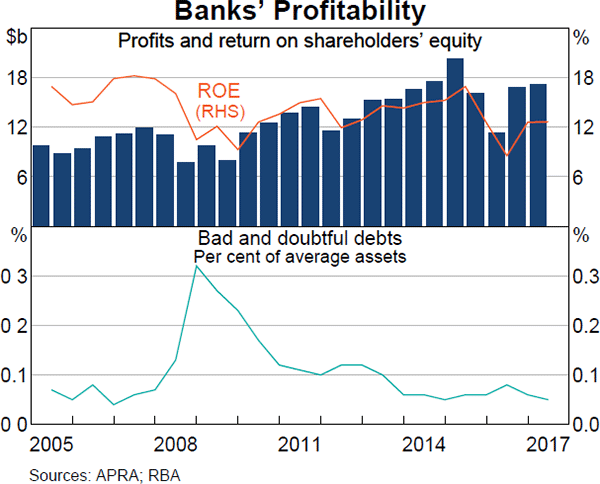
The increase in capital over recent years, despite flat profits, has reduced banks' ROE below its historical average. Banks have partly offset this by making some adjustments to their lending activities.[4] This has included a continued shift towards housing lending, which requires less capital, and has generated higher ROE than other activities. Banks have also scaled back activities that are more capital intensive and do not generate sufficient returns to offset the capital required. As noted earlier, this has included some international activities and institutional lending. Most of the major banks have also sold (or are in the process of selling) parts of their wealth management and life insurance operations.
The share prices of Australian banks have declined over the past six months, underperforming global peers. The price fall has seen banks' forward earnings yields – a proxy for investors' expected rate of return – rise both in absolute terms and relative to the broader market (Graph 3.11). Banks' current forward earnings yields are around their pre-crisis average, despite a large decline in risk-free rates since then.
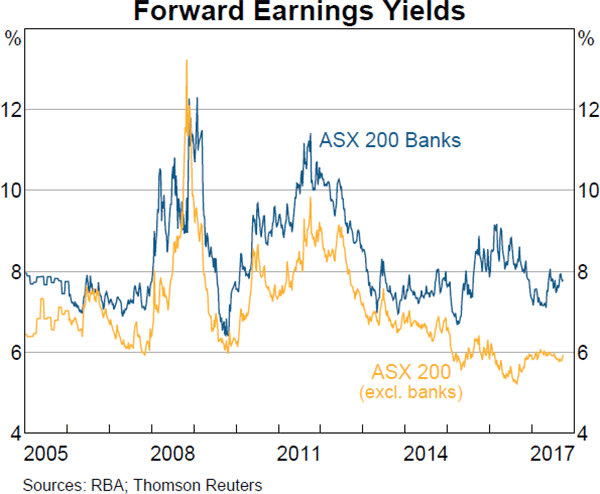
Bank Culture
Global experience is that the culture within banks can have a major bearing on how a wide range of risks are identified and managed. There have been a number of examples where the absence of strong positive culture has given rise to a deterioration in asset performance, misconduct and loss of public trust. In Australia, there have also been examples of weak internal controls causing difficulties for some banks. These include in the areas of life insurance, wealth management and, more recently, retail banking. In August, AUSTRAC (the Australian Transaction Reports and Analysis Centre) initiated civil proceedings against the Commonwealth Bank of Australia for breaches of the Anti-Money Laundering and Counter-Terrorism Financing Act 2006. In the current environment where investors still expect high rates of return, despite regulatory and other changes that have reduced bank ROE, banks need to be careful of taking on more risk to boost returns.
A central element to address this issue is to ensure that banks build strong risk cultures and governance frameworks. Regulators have therefore heightened their focus on culture and the industry is taking steps to improve in this area. APRA's powers will be strengthened once the Banking Executive Accountability Regime (BEAR) announced in this year's Federal Budget is legislated. The BEAR strengthens APRA's abilities to impose civil penalties and dismiss bank executives for poor conduct, and requires a significant share of executives' incentive remuneration to not vest for at least four years (although banks already largely adhere to this). APRA has also established an independent inquiry to identify whether there are deficiencies in governance, culture and accountability frameworks and practices at the Commonwealth Bank of Australia and, if so, how these can be addressed. The banking industry's own initiatives to improve culture include background checks aimed at preventing individuals with a history of misconduct moving within the industry, and rewriting the Code of Banking Practice to strengthen its commitment to customers.
Shadow Banking
Shadow bank lending can support economic growth by providing credit to borrowers that don't easily meet bank standards but, because it is less regulated, on a large enough scale it could damage financial system resilience. While tighter post-crisis prudential regulation for banks increases the chance that credit activities migrate to the less regulated shadow banking sector, there is little evidence of this so far in Australia. The shadow banking sector remains small – only 7 per cent of the financial system – and about half the size it was in 2007 (Graph 3.12). The fall in the shadow bank market share occurred as the crisis intensified and sourcing funding became more difficult, and the sector has not regained market share as funding markets have normalised. Systemic risks to the financial system are limited by banks' exposures to the sector, which are only a few per cent of their assets.
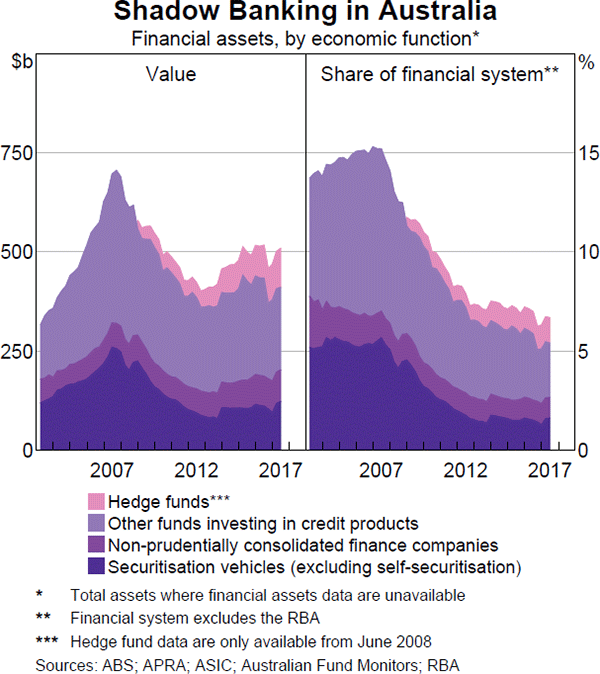
Property lending by shadow banks warrants attention given the tightening of lending standards at prudentially regulated entities. In line with the trends noted above, the available evidence suggests that shadow banks' share of residential mortgage lending has increased only slightly over the past few years and remains well below pre-crisis levels (Graph 3.13).[5] For property development, there are limited data on the extent of shadow banks' lending. However, liaison suggests that this type of lending has increased relatively strongly over the past year or so, but has not fully offset the pullback by large banks. Much of this shadow bank finance is expensive mezzanine debt that poses less risk to financial stability, in part because it occurs with some regulatory oversight if a bank provides the senior debt. However, there has also been some growth in shadow banks' provision of senior debt.
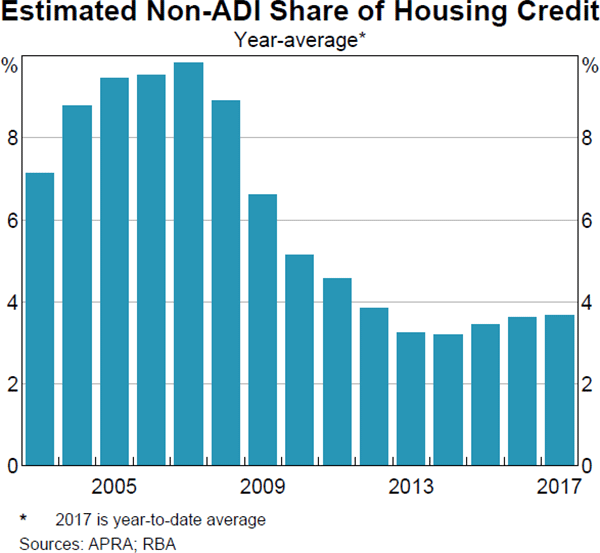
A key constraint to a rapid expansion of shadow bank property lending is the cost and availability of funding. Non-bank mortgage originators require warehouse funding (revolving finance until mortgages are securitised), which banks could be reluctant to provide due to regulatory issues. Longer-term funding is typically through RMBS and while this market is recovering, RMBS pricing is still well above the cost of bank funding (deposits or senior unsecured bank debt). This tends to push shadow banks using this business model to lend to borrowers with lower credit quality that pay higher interest rates.
Proposed legislation will improve the quality of data supplied to regulators by some shadow banks, making it easier to monitor these activities and assess their impact on financial stability. Related legislation will also grant APRA powers to impose rules on non-ADIs if their activities pose a threat to financial stability.
Insurance
General insurers' profits have been broadly steady over the past year, but ROE for the sector remains around the bottom of the range observed over the past decade (Graph 3.14). The decline in ROE compared with its historical average has mainly resulted from a material fall in investment income as interest rates declined. Underwriting performance has also been weaker than historically, but has recovered a little over the past year as insurers managed to reverse earlier downward pressure on some commercial premiums. Despite higher natural disaster claims due to cyclones, earthquakes and hailstorms, the claims ratio (net incurred claims relative to net premium) also fell as lower-than-expected inflation allowed insurers to release more reserves. The general insurance industry remains well capitalised, with capital equivalent to 1.8 times APRA's prescribed amount.

Lenders mortgage insurers' profits remain under pressure, but the sector remains well capitalised at 1.6 times APRA's prescribed amount. Profits continue to decline due to a decrease in revenue, as banks reduce high-LVR mortgage lending, and claims increase in Western Australia and Queensland. These headwinds seem likely to persist, given APRA's efforts to limit the flow of new high-LVR interest-only loans.
Life insurance profitability has stabilised due to an improvement in the individual death and total and permanent disability parts of the industry, and because large write-downs in prior periods have not been repeated. However, ROE remains low and the industry is still reporting considerable losses on individual disability income insurance (commonly known as ‘income protection insurance’) due to structural issues (Graph 3.15). These include longstanding deficiencies in pricing, loose product definitions and rising claims, especially for mental health. Problems in the life insurance industry will take some time to resolve given the long-term nature of life insurance contracts. Given that, the industry has responded by reducing risk through additional reinsurance and by increasing its capital to 1.9 times APRA's prescribed amount.
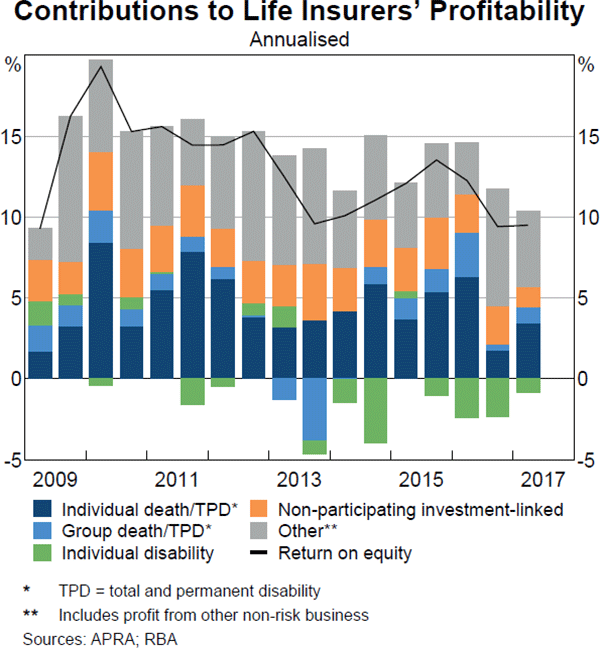
Superannuation
The superannuation sector remains a large and growing part of Australia's financial system. Total assets amount to $2.3 trillion, accounting for three-quarters of the assets in the managed fund sector (a higher share than in other advanced economies) and equivalent to around half the size of the Australian banking system. Total superannuation assets grew by 10 per cent in the year to June 2017, slightly higher than the post-crisis average. Growth was supported by stronger investment returns as global share markets rallied and higher member contributions in advance of changes to the concessional contributions cap that took effect on 1 July.
The financial stability risks inherent in the superannuation industry are lower than for other parts of the financial system because debt funding accounts for a very small share of its total liabilities. This is particularly true for APRA-regulated funds, which are not generally permitted to borrow. Self-managed superannuation funds (SMFS) are permitted to use debt with limited recourse and the use of such debt has increased in recent years, mainly to fund the purchase of property (Graph 3.16). Despite this, leverage in SMSF as a whole remains very small (only a few per cent of total assets) and at this stage poses little risk to financial stability.
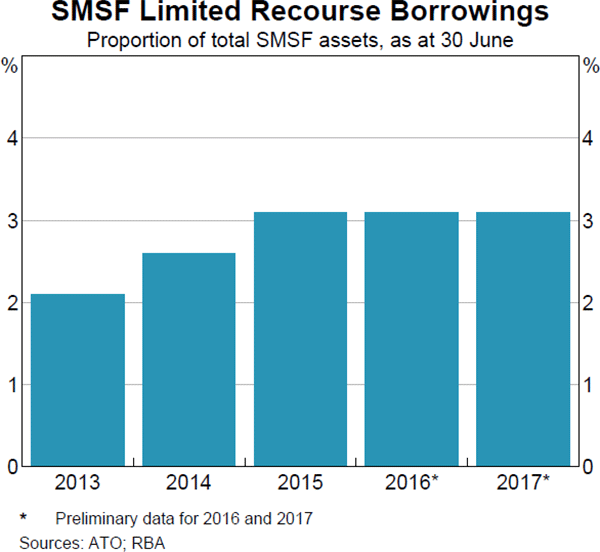
Financial Market Infrastructures
Financial market infrastructures (FMIs) are institutions that facilitate the clearing, settlement or recording of payments, securities, derivatives or other financial transactions. Over recent years there has been considerable effort to strengthen the regulation and supervision of FMIs because of their central role in the financial system. The Reserve Bank has oversight responsibilities for the stability of FMIs operating in Australia.
The key FMIs located in Australia are the Reserve Bank Information and Transfer System (RITS) – which banks and other approved institutions use to settle payment obligations on a real-time basis – and the ASX clearing and settlement facilities – which facilitate the clearing and settlement of trades in securities and derivatives. RITS processed around 6 million transactions in the six months to September, with an aggregate value of $22 trillion. There have been no major incidents impacting RITS during this time and the number and frequency of incidents remained at historical lows. All of the key ASX facilities also met their operational availability target of 99.9 per cent during this period. However, in light of a number of operational incidents, ASX has commissioned an external assessment of its operational risk management arrangements.
One recent focus of the Reserve Bank's oversight of ASX has been the margining arrangements of its two central counterparties (CCPs). Margin posted to the CCP by each participant is the first layer of financial protection against potential losses in the event of that participant's default. Overall, the Reserve Bank concluded that these CCPs had well-established margining arrangements that have been enhanced over recent years. However, the Reserve Bank noted that ASX Clear (Futures) does not currently have the operational capacity to collect margin during the night session, when almost 40 per cent of trading in its futures contracts occurs. This exposes the CCP to the risk of holding inadequate collateral against default if market prices move sharply during this time. In response to the Reserve Bank's concerns, ASX Clear (Futures) has started to require certain participants to lodge a ‘buffer’ of additional margin during the night session. In the longer term, ASX plans to manage its overnight risk by implementing real-time margining capabilities on a 24/6 basis, including scheduled overnight margin runs.
A second focus of the Reserve Bank's oversight of ASX CCPs has been their management of investment risk. This has seen ASX recently implement changes to its treasury investment policy that limits its unsecured exposure to individual non-government-related issuers or counterparties; each exposure can be no larger than the level of business risk capital held across the two CCPs (currently $75 million).
In line with other areas of the financial system, management of cyber risk is a significant and growing focus for FMIs. The Reserve Bank has conducted a detailed assessment of the main domestic FMIs against the governance chapter of the international guidance on cyber resilience.[6] To complement this assessment, the Reserve Bank has required these FMIs to conduct a self-assessment against the remaining chapters of the guidance and have their arrangements externally reviewed against industry standards on cyber resilience. These assessments have been completed for RITS and work is underway for the ASX clearing and settlement facilities. To date, these assessments have not identified any significant issues. Consistent with the international guidance, these FMIs have also developed concrete plans to improve their capabilities to recover from a cyber attack. Work is also progressing to enhance the cyber resilience of FMI members. RITS recently updated its Business Continuity Standards for RITS members to specifically address cyber security. SWIFT, a key provider of payments messaging infrastructure to the financial industry, has also announced a new policy framework for ensuring users of its infrastructure apply appropriate security controls.
Footnotes
Impaired loans are those that are not well secured and where there are doubts as to whether the full amounts due will be obtained in a timely manner. Past-due loans are at least 90 days in arrears, but well secured. [1]
APRA (2017), ‘Strengthening Banking System Resilience – Establishing Unquestionably Strong Capital Ratios’, Information Paper, 19 July. [2]
The level of required capital under the new capital standards need not increase if risk weights are increased for a particular type of lending because this could be offset by other changes to the capital framework. [3]
For more information, see Atkin T and B Cheung (2017), ‘How Have Australian Banks Responded to Tighter Capital and Liquidity Requirements?’ RBA Bulletin, June, pp 41–50. [4]
See Gishkariany M, D Norman and T Rosewall (2017), ‘Shadow Bank Lending to the Residential Property Market’, RBA Bulletin, September, pp 45–52 for more details. [5]
CPMI-IOSCO (2016), Guidance on Cyber Resilience for Financial Market Infrastructures, June. Available at <http://www.bis.org/cpmi/publ/d146.htm>. [6]